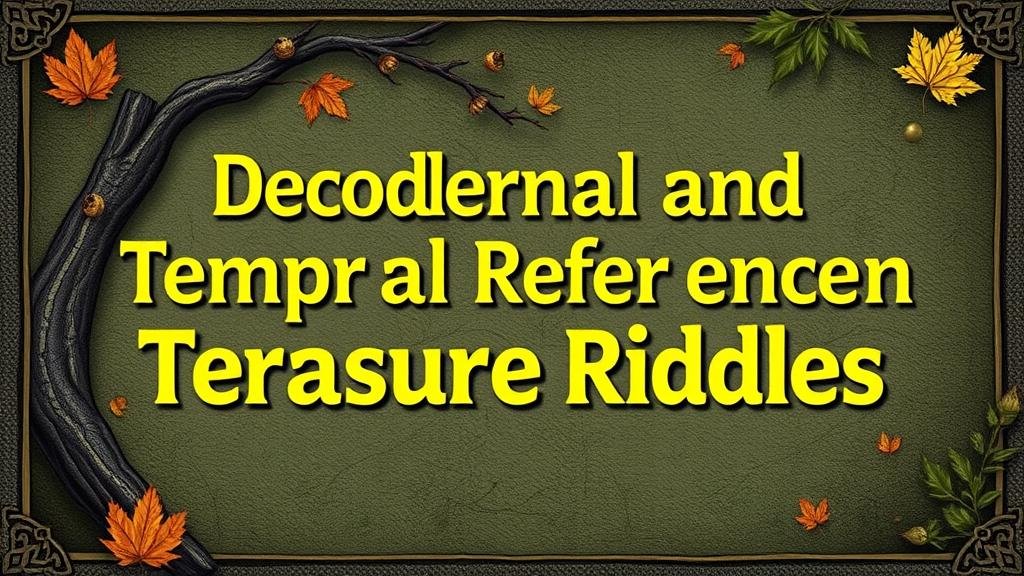Decoding Seasonal and Temporal References in Treasure Riddles
Decoding Seasonal and Temporal References in Treasure Riddles
Treasure riddles have captivated audiences for centuries, weaving a complex tapestry of history, culture, and cognitive challenge. Within these enigmas lies a treasure trove of seasonal and temporal references that serve as crucial clues for deciphering their meaning. This article explores the methodologies for decoding these references, illustrating how they function as navigational aids in the quest for hidden treasures.
Understanding Seasonal References
Seasonal references in treasure riddles frequently allude to specific times of the year and can encompass elements such as weather patterns, agricultural cycles, and significant cultural events. Each season carries its own distinct characteristics, which can provide cryptic clues when analyzing riddles.
For example, consider a riddle that states, “When frost first bites the field, seek where the shadows yield.†Here, the mention of “frost†suggests a temporal marker associated with autumn or early winter–it indicates a specific time when farming activities slow down. The phrase “shadows yield†points to locations that may be distinguished by the positioning of the sun, which ties in the concept of daylight hours and shadows pertinent during that season.
Temporal References: The Element of Time
Temporal references revolve around specific times or chronological markers, such as time of day, dates, or generational markers. These references often act as implicit guides directing an individual to the right moment to search or observe.
An illustrative example is found in the riddle: “At the stroke of ten where the bird takes flight, the first rays of dawn will guide you right.†This riddle utilizes time (“the stroke of tenâ€) as a precise temporal reference, indicating when the seeker should be in position. Coupled with the mention of “the first rays of dawn,†it emphasizes the importance of synchronizing actions with both chronological and natural events.
Case Studies: Historical Examples
Several notable treasure riddles throughout history exemplify the utilization of seasonal and temporal themes. One prominent case is the “Treasure of Oak Island,†which has been the subject of numerous theories since the 18th century. The original riddle referenced specific tides and moon phases, which many researchers believe indicate the timing necessary to access the mysterious site.
Another remarkable riddle is found in the famous “Beechworth Gold Riddle,†which hints at not only the gold itself but also the seasons influencing mining operations in early Australia. Such riddles encapsulate both the local climate and historical practices, allowing treasure hunters to make educated guesses based on the time of year and natural occurrences.
Decoding Methodologies
Decoding seasonal and temporal references within riddles requires a multifaceted approach involving historical research, cultural understanding, and natural observation. Here are effective strategies to unlock these references:
- Contextual Analysis: Investigate the cultural and historical context of the riddle. Understanding the time periods and significant events can provide insights into the seasonal references.
- Natural Observation: Pay attention to local flora and fauna, as well as seasonal weather patterns. This information can enrich the interpretation of clues.
- Chronological Mapping: Create a timeline that correlates the riddle’s clues with specific dates or time frames. This can help pinpoint exact moments significant to the search.
Real-World Applications
The ability to decode seasonal and temporal references is not just limited to treasure hunting; it has applications in various fields such as archaeology, anthropology, and even literature analysis. For example, archaeologists often utilize temporal references in historic riddles to date artifacts or sites based on agricultural or seasonal patterns described in local folklore.
Similarly, in literature, authors often embed seasonal motifs and time-related hints to deepen storytelling. Analyzing these references can enhance the understanding of narrative developments and character motivations.
Conclusion: The Quest for Knowledge
Decoding seasonal and temporal references in treasure riddles enhances the thrill of the hunt and enriches our understanding of cultural and historical contexts. By applying sound methodologies–including contextual analysis, natural observation, and chronological mapping–individuals can unravel the mysteries contained within these intriguing puzzles. Ultimately, the journey to understanding these references not only leads treasure seekers to riches but also to a deeper appreciation of the interplay between time, nature, and human ingenuity.
For anyone engaged in treasure riddles, remember that the path to discovery is as valuable as the treasure itself. Equip yourself with knowledge, remain curious about the seasons, and be aware of the rhythms of time–they may guide you to your own hidden treasures.



